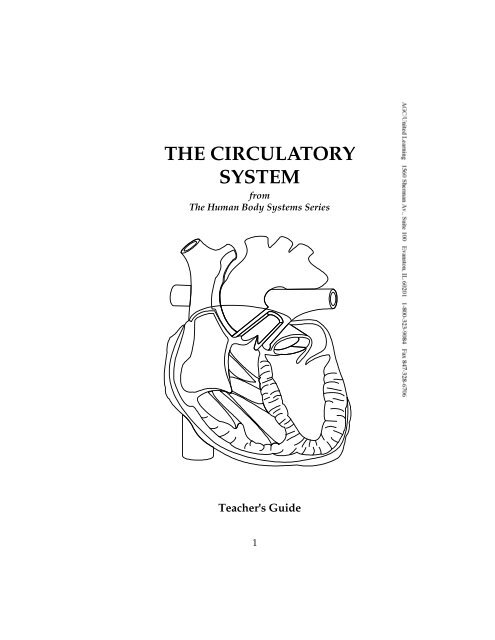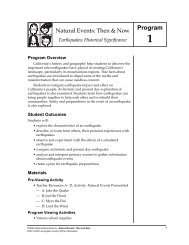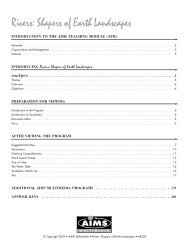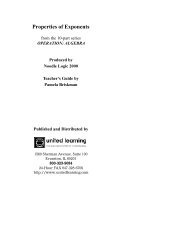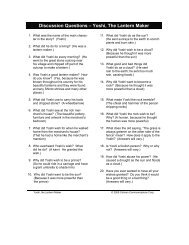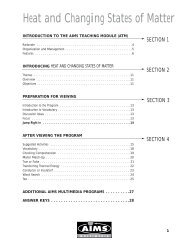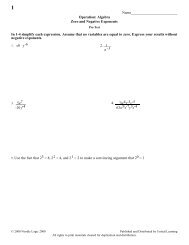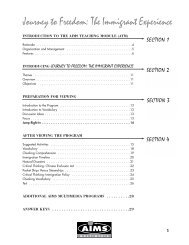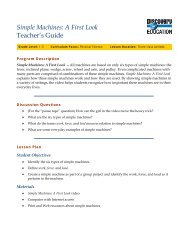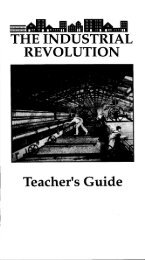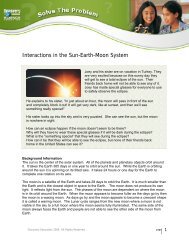THE CIRCULATORY SYSTEM - Discovery Education
THE CIRCULATORY SYSTEM - Discovery Education
THE CIRCULATORY SYSTEM - Discovery Education
Create successful ePaper yourself
Turn your PDF publications into a flip-book with our unique Google optimized e-Paper software.
<strong>THE</strong> <strong>CIRCULATORY</strong><br />
<strong>SYSTEM</strong><br />
from<br />
The Human Body Systems Series<br />
Teacher's Guide<br />
1
The Circulatory System<br />
from<br />
The Human Body Systems Series<br />
catalog # 3135<br />
Published & Distributed by…<br />
AGC/UNITED LEARNING<br />
1560 Sherman Avenue<br />
Suite 100<br />
Evanston, IL 60201<br />
1-800-323-9084<br />
24-Hour Fax No. 847-328-6706<br />
Website: http://www.agcunitedlearning.com<br />
E-Mail: info@agcunited.com<br />
2
<strong>THE</strong> <strong>CIRCULATORY</strong> <strong>SYSTEM</strong><br />
Grade Levels: 6 - 9<br />
(Review for grades 10-12)<br />
Viewing Time: 20 minutes with video quiz<br />
INTRODUCTION<br />
This video is designed for use in grades 6-9 as an introduction<br />
to the major ideas and concepts associated with the<br />
human circulatory system, and for use in grades 10-12 as<br />
review.<br />
PROGRAM OBJECTIVES<br />
After viewing the video and participating in the lesson activities,<br />
the students will be able to…<br />
• Describe the function and workings of the circulatory system.<br />
• Identify the main parts of the circulatory system.<br />
• Identify the three types of blood vessels found in the human<br />
circulatory system.<br />
• Define key vocabulary terms associated with the circulatory<br />
system.<br />
SUMMARY OF <strong>THE</strong> VIDEO<br />
This video describes the functions of the human circulatory<br />
system. It is the main transport system of the body<br />
and is responsible for suppling the trillions of living cells<br />
in our bodies with the food and oxygen necessary for survival.<br />
In addition to bringing fresh supplies of food and<br />
oxygen, the circulatory system carries away from the cells<br />
waste products that must be eliminated from the body. The<br />
circulatory system works with the digestive system, the<br />
3
espiratory system, and the excretory system to perform<br />
these functions. The center of the circulatory system is the<br />
four-chambered heart. The parts and functions of the heart<br />
are described and illustrated through the use of computer<br />
generated artwork and animation. The three types of blood<br />
vessels are presented as well as a discussion of the makeup<br />
of blood. Blood clotting and methods for maintaining a<br />
healthy circulatory system are presented at the end of the<br />
tape.<br />
INSTRUCTIONAL NOTES<br />
Before presenting this lesson to your students, we suggest<br />
that you preview the video and review this guide and the<br />
accompanying blackline master activities in order to familiarize<br />
yourself with their content. Duplicate any blackline<br />
masters you wish to distribute. If you plan to use the Video<br />
Quiz, which immediately follows the video presentation,<br />
you may wish to distribute Blackline Master 1, Video Quiz,<br />
before showing the video.<br />
As you review the materials presented in this guide, you<br />
may find it necessary to make some changes, additions, or<br />
deletions to meet the specific needs of your class. We encourage<br />
you to do so, for only by tailoring this program to<br />
your class will they obtain the maximum instructional benefits<br />
afforded by the materials.<br />
It is also suggested that the video presentation take place<br />
before the entire group under your supervision. The lesson<br />
activities grow out of the context of the video; therefore,<br />
the presentation should be a common experience for<br />
all students.<br />
4
INTRODUCING <strong>THE</strong> VIDEO<br />
Ask the students to make a fist. Then ask them to open the<br />
fist. Ask them to do that procedure of making a fist and<br />
then opening it as quickly as they can for the next minute.<br />
After the minute, most people will recognize that the<br />
muscles in their fingers and hands are tired or fatigued.<br />
Now ask them to think about an organ in their body that<br />
never fatigues and works so hard that it pumps 2,000 gallons<br />
of blood everyday throughout their body. Of course,<br />
we are talking about the heart. The topic for today’s video<br />
is the heart and the rest of the circulatory system that is so<br />
essential to life.<br />
Present the video. The viewing time is 15 minutes for the<br />
program and about 5 minutes for the Video Quiz.<br />
BLACKLINE MASTER DESCRIPTIONS<br />
Most of the follow-up activities for this program are designed<br />
for middle school grades. If you use this program<br />
with an older audience, you will need to adapt the materials<br />
appropriately.<br />
• Blackline Master 1, Video Quiz, is to be used at the end<br />
of the video program. At the completion of the video there<br />
is a short ten-question quiz. The narrator will read the questions<br />
which are displayed on the screen. Students can use<br />
this sheet to record their answers. Answers to the questtions<br />
are provided in the Answer Key found on page 5.<br />
• Blackline Master 2, Vocabulary, is a collection of important<br />
vocabulary words from the video. You may want to<br />
distribute this sheet before viewing the video so students<br />
can listen for definitions.<br />
5
• Blackline Master 3, Naming The Parts of a Heart, asks<br />
students to use the words at the bottom of the page to label<br />
the illustration of a heart.<br />
• Blackline Masters 4 qnd 5, Stages of a Heartbeat and<br />
Stages of a Heartbeat 2, are designed to be used together.<br />
Students are asked to describe what is happening during<br />
each of the four stages of a heartbeat. The first sheet provides<br />
illustrations of each stage and the second sheet provides<br />
spaces for students to record what is happening.<br />
• Blackline Master 6, Blood Types, is an information sheet<br />
that discusses a topic not covered in the video program,<br />
the ABO blood system.<br />
• Blackline Masters 7, Quiz, is the formal test for this unit<br />
of study.<br />
INTERNET ACTIVITIES<br />
1. Visit The Heart website at<br />
http://johns.largnet.uwo.ca/shine/health/heart.htm<br />
for great information about the heart and the circulatory<br />
system.<br />
2. The Heart and the Circulatory System provides history<br />
of human thought on the workings of the circulatory system<br />
at<br />
http://www.gene.com/ae<br />
This information can be accessed by typing the words "heart<br />
and the circulatory system" in the site's search engine.<br />
DISCUSSION QUESTIONS<br />
1. Discuss how the circulatory system works with other<br />
systems to deliver food and oxygen to the living cells of<br />
the body.<br />
6
2. Discuss how the cardiac muscle of the heart is different<br />
from other muscles found in the body.<br />
3. Discuss how students can maintain healthy hearts and<br />
circulatory systems. Why would a balanced diet and exercise<br />
be important<br />
ANSWER KEY<br />
Blackline Master 1, Video Quiz<br />
1. The job of the circulatory system is to transport food and<br />
oxygen to all of the trillions of living cells in a human body.<br />
It also must pick up waste products from those cells so that<br />
they can be eliminated from the body.<br />
2. Heart, blood, blood vessels.<br />
3. Right atrium, right ventricle, left atrium, and left ventricle.<br />
4. The lub-dub sound is the sound of heart valves closing.<br />
5. Arteries, capillaries, veins.<br />
6. One-way valves, and the fact that veins are between leg<br />
muscles so when a person walks, the contracting and relaxing<br />
muscles help push the blood along.<br />
7. The first number is the pressure of blood as it is pushed<br />
by the ventricles. The other number is the pressure at rest<br />
while the ventricles are refilling.<br />
8. 5 liters.<br />
9. Plasma, red blood cells, white blood cells, and platelets.<br />
10.Hemoglobin attracts and holds onto oxygen molecules.<br />
It carries the oxygen through the circulatory system.<br />
Blackline Master 2, Vocabulary<br />
1. artery - blood vessel that carries blood away from the<br />
heart<br />
2. vein - blood vessel that carries blood back to the heart<br />
3. capillary - smallest blood vessel found between arteries<br />
and veins<br />
4. atrium - one of two upper chambers of the heart<br />
7
5. ventricle - one of two lower chambers of the heart<br />
6. aorta - main artery of the body<br />
7. plasma - yellowish fluid that makes up more than 50%<br />
the volume of blood; it contains nutrients, hormones, and<br />
minerals and is about 90% water<br />
8. red blood cell - carries the oxygen throughout the circulatory<br />
system<br />
9. white blood cell - these cells are the body's main defense<br />
against germs and bacteria<br />
10. platelets - blood cells which help with blood clotting<br />
11. coronary circulation - the heart needs a constant and<br />
fresh supply of blood which is delivered by the coronary<br />
circulation system<br />
12. hemoglobin - a substance that attracts and holds onto<br />
oxygen molecules; hemoglobin is in the red blood cells<br />
13. bone marrow - inside certain long bones of the body,<br />
the bone marrow is the site of blood cell production and<br />
storage<br />
14. fibrin - long thread-like mesh that helps clot blood<br />
15. clot - seals a wound by forming a thickened concentration<br />
of blood<br />
16. pacemaker - an area of the heart that regulates or signals<br />
the beating of the heart<br />
17. cardiac muscle - the heart<br />
18. one-way valve - a valve that allows the flow of blood in<br />
only one direction<br />
19. pulmonary arteries - arteries which carry carbon dioxide<br />
rich blood from the heart to the lungs<br />
20. pulmonary veins - veins which carry the oxygen-rich<br />
blood from the lungs back to the heart<br />
8
Blackline Master 3, Naming the Parts of the Heart<br />
Blackline Masters 4 & 5, Stages of the Heartbeat 1 and 2<br />
Stage #1 : Blood enters the right and left atria. Blood that<br />
enters the right atrium is coming from the body and is carrying<br />
carbon dioxide. Blood entering the left atrium is returning<br />
from the lungs and is rich with oxygen.<br />
Stage #2: The blood moves from the atria into the two ventricles<br />
when one-way valves open up.<br />
Stage #3: The one-way valves close, trapping the blood in<br />
the ventricles.<br />
Stage #4: The other valves of the ventricles open. From<br />
the right ventricle, the blood is pushed to the pulmonary<br />
artery which carries the carbon dioxide-rich blood to the<br />
two lungs. The blood from the left ventricle is given a<br />
mighty push to carry it into the aorta, the main artery of<br />
the body.<br />
9
Blackline Master 6, Blood Types<br />
Blood Type Can Donate to Group<br />
A<br />
A, AB<br />
B<br />
B, AB<br />
AB<br />
AB<br />
O<br />
A, B, AB, O<br />
Blackline Master 7, Quiz<br />
1. The role of the circulatory system is to transport food<br />
and oxygen to the living cells of the body. It also collects<br />
waste products from the cells to be eliminated from the<br />
body.<br />
2. Plasma is a yellowish fluid that makes up 50% of the volume<br />
of blood. Floating in the plasma are nutrients, hormones,<br />
and minerals. Red blood cells carry the oxygen<br />
throughout the body. White blood cells are an important<br />
part of the body’s immune system. They attack germs.<br />
Platelets help blood clot when there is a cut.<br />
3. Blood enters the right atrium from veins that are returning<br />
blood to the heart. The blood moves through a oneway<br />
valve into the right ventricle, which pushes the blood<br />
into the pulmonary arteries that lead to the lungs. The blood<br />
goes into the lungs, where it releases carbon dioxide and<br />
picks up oxygen. The now oxygen-rich blood returns to<br />
the heart by entering the left atrium. It goes through a oneway<br />
valve and into the left ventricle where it will get a major<br />
push through a final valve and into the aorta, the major<br />
artery of the body.<br />
4. Arteries carry blood away from the heart. They have to<br />
be strong but flexible because of the powerful push from<br />
the left ventricle. Capillaries are the smallest blood vessels,<br />
about the size of a single red blood cell. The transfer<br />
of nutrients, oxygen, and wastes takes place at the capil-<br />
10
lary level. Veins are blood vessels that return blood to the<br />
heart. They contain one-way valves to prevent blood from<br />
flowing backwards.<br />
5. If blood types that are not compatible are mixed, clumping<br />
chemicals anti-A and anti-B will recognize the other<br />
blood as foreign and cause it to clump. The clumping could<br />
lead to blockage in blood vessels.<br />
6. The left ventricle must give the blood the major push it<br />
needs to travel throughout the circulatory system to all parts<br />
of the body.<br />
7. If there are a lot of white blood cells present, then it indicates<br />
that the body is fighting off an infection and germs.<br />
8. The first number is the measure of the strongest pressure<br />
during the time blood is forced out of the ventricles.<br />
The second number is taken during the rest period while<br />
the ventricles are refilling with blood.<br />
9. Hypertension is used to describe people who have high<br />
blood pressure readings during periods of rest. This can<br />
be harmful to delicate body organs.<br />
10. Eating foods low in fat can help avoid the clogging of<br />
arteries. Exercise can be very helpful to a muscle like<br />
the heart.<br />
SCRIPT OF VIDEO PRESENTATION<br />
<strong>THE</strong> <strong>CIRCULATORY</strong> <strong>SYSTEM</strong><br />
Your body is made up of trillions of living cells and everyone<br />
of them needs food and oxygen to stay alive. Whether<br />
you are exercising, just sitting around, or even sleeping,<br />
the circulatory system is busy working to get fresh oxygen<br />
and food to all parts of the body.<br />
11
It is the job of the circulatory system to transport food and<br />
oxygen to the cells and then to collect waste products so<br />
that they can be eliminated from the body. This system<br />
operates non-stop from before birth to death. If deprived<br />
of oxygen for just a few minutes, a cell will begin to die.<br />
This system is crucial to survival.<br />
The circulatory system is made up of three main parts or<br />
components: the heart, the blood, and the vessels through<br />
which the blood flows. Let’s begin our exploration by looking<br />
at the heart.<br />
<strong>THE</strong> HEART<br />
The heart is about the size of an adult’s fist and is located<br />
just to the left of the center of a human’s chest. The heart is<br />
protected by the rib cage. More than fifty percent of the<br />
heart’s weight is muscle. However, this is a special muscle<br />
called the cardiac muscle. It is made of muscle fiber that<br />
doesn’t become tired or fatigued after prolonged use.<br />
Muscles in your arms and legs are different, and after<br />
strenuous use they become fatigued. The heart can never<br />
become tired because it is constantly working night and<br />
day for your entire life.<br />
It beats at about 70 beats per minute during times of rest.<br />
During each of these beats, about 70 milliliters of blood are<br />
pumped out to the body. This graduated cylinder contains<br />
70 milliliters of colored water to give you an idea of<br />
how much blood is pushed out of the heart with every beat.<br />
The rate of beating is controlled or regulated by an area of<br />
nerve tissue located in the upper-right side of the heart.<br />
This area is called the pacemaker and sends out signals to<br />
the heart muscle causing it to contract. If something happens<br />
to the pacemaker, an artificial or human-made pacemaker<br />
can be used, either inside the body or on the outside<br />
to send the necessary signals for heart movement.<br />
12
The heart is made up of two pumps, one on the right side<br />
and one on the left side. A wall of thick tissue, called the<br />
septum, separates the heart into these two sides. There are<br />
two chambers found on each side, for a total of four chambers.<br />
The two upper chambers are called atria and the two<br />
lower chambers are called ventricles.<br />
In the right atrium, blood is collected as it returns from its<br />
trip throughout the body. This blood has very little oxygen,<br />
but is carrying carbon dioxide, a waste product released<br />
from the body’s living cells. The color of this blood<br />
is dark red. At the bottom of the right atrium is a one-way<br />
valve that opens to allow the blood into the lower chamber,<br />
called the right ventricle. The one-way valve will not<br />
permit the blood to flow backwards into the upper chamber.<br />
This is a muscular chamber that contracts with great<br />
force. It pushes the blood through the semilunar valve into<br />
the pulmonary artery.<br />
The pulmonary artery divides into two paths leading to<br />
the two lungs. The blood, rich with the waste product carbon<br />
dioxide, moves into the capillaries, or smallest blood<br />
vessels of the lungs. Here there is a gas exchange as the<br />
carbon dioxide passes from the blood into the lungs where<br />
it will be exhaled from the body.<br />
The air breathed into the lungs has oxygen in it. The oxygen<br />
moves into the blood to be carried to the body’s cells.<br />
The pulmonary veins bring the now oxygen-rich blood back<br />
to the heart. It enters the left atrium and then moves into<br />
the left ventricle. The blood is now a bright red because it<br />
is rich with oxygen. The left ventricle contracts, forcing<br />
the blood into the aorta, which is the largest artery in the<br />
body. The blood is now on its way throughout the body.<br />
The left ventricle actually works about six times harder than<br />
the right ventricle because it is responsible for giving the<br />
blood the push it needs to travel throughout the whole body.<br />
13
The right ventricle is merely sending the blood into the pulmonary<br />
arteries which take it a short distance to the lungs.<br />
The lub-dub sound that is heard when listening to the heart<br />
is the sound of the different valves shutting as blood flows<br />
through them. The valves are designed only to allow blood<br />
to flow in one direction. The four stages of a heartbeat as<br />
described above take about a second to occur.<br />
BLOOD VESSELS<br />
The blood travels through the body in a continuous system<br />
of tubes called blood vessels. This system is so huge<br />
that if one person’s blood vessels were stretched out<br />
straight, they would reach almost half way to the moon.<br />
There are three types of blood vessels: arteries, veins, and<br />
capillaries. Arteries are large blood vessels that carry the<br />
blood away from the heart. Arteries divide into smaller<br />
and smaller vessels, until they are so small they can only<br />
be seen through a microscope. These vessels are called capillaries.<br />
There are so many of these vessels that most living<br />
cells of the body are close to capillaries. The capillaries<br />
rejoin to form veins, which are the blood vessels that return<br />
blood to the heart. In this diagram, the arteries are<br />
shown in red to represent oxygen-rich blood and the veins<br />
are shown in blue to show oxygen-poor blood.<br />
The largest artery is called the aorta. It is about 1 inch in<br />
diameter and receives the push of blood from the left ventricle.<br />
There is quite a bit of pressure behind this push, so<br />
arteries are designed to be flexible. They expand and then<br />
move back to their original sizes and shapes, which provides<br />
even more push.<br />
Some of the blood is directed immediately back to the heart<br />
to provide it with nutrients and oxygen. The heart cells<br />
need to be continuously supplied with nourishment.<br />
14
Through coronary circulation, blood is supplied to the blood<br />
vessels of the heart. If the cells of the heart aren’t supplied<br />
with oxygen or nutrients, a heart attack can result. Heart<br />
attacks are a leading cause of death in the United States.<br />
They can be caused by blood clots that block blood vessels<br />
or buildup of cholesterol, fibrin, or other material in blood<br />
vessels can narrow the path or openings in the vessels.<br />
Remember that one of the critical jobs of the circulatory<br />
system is to transport oxygen and food to all living cells<br />
and then to collect waste products, such as carbon dioxide.<br />
The exchange of gases takes place in the capillaries. These<br />
vessels are so small that they are only one cell thick. This<br />
makes the transfer of materials possible. There are so many<br />
capillaries that every living cell in the body is within their<br />
reach. The capillaries are so thin that red blood cells have<br />
to squeeze through them one cell at a time.<br />
After blood cells have delivered nourishment and picked<br />
up wastes, they move into larger vessels called veins. Veins<br />
return blood to the heart. They are structured similarly to<br />
arteries, with three layers of muscle and connective tissue.<br />
Veins must overcome the pull of gravity to get the blood<br />
back to the heart. The push from the heart that propels the<br />
blood through the arteries is no longer much of a factor.<br />
There are two things that help to move the blood through<br />
the veins. The larger veins have one-way valves that prevent<br />
the blood from flowing backwards. The veins are located<br />
between skeletal muscles, and when the muscles contract,<br />
they force the blood forward through the veins and<br />
towards the heart.<br />
If a person stands still for awhile, the blood will collect in<br />
his or her feet and ankles. If this continues and the brain<br />
doesn’t get enough blood, a person might faint. When<br />
people walk, jog, or run, the muscles in the legs contract<br />
15
and relax, which causes the veins to be squeezed and released.<br />
This causes the blood to move along the vein towards<br />
the heart.<br />
BLOOD PRESSURE<br />
To move the blood through this network of vessels, a great<br />
deal of force and pressure is required. The force is provided<br />
by the heart and is at its highest when the ventricles<br />
contract, forcing blood out of the heart and into the arteries.<br />
Then there is a drop in pressure as the ventricles refill<br />
with blood for the next heartbeat.<br />
Doctors measure the blood pressure with a device called a<br />
sphygmomanometer. They always measure blood pressure<br />
in the upper arm artery. Blood pressure varies throughout<br />
the body, so a standard place must be used so that a person’s<br />
blood pressure can be compared over time and with other<br />
people. There are two pressure readings. One measures<br />
the strongest pressure during the time blood is forced out<br />
of the ventricles. The second reading is taken during the<br />
rest period, as the ventricles refill with blood. The first reading<br />
is called a systole and the reading at refill is called a<br />
diastole. The numbers are written together, such as 120<br />
over 80, which happens to be the blood pressure of a healthy<br />
young adult.<br />
Blood pressure will change according to the activity in<br />
which the person is engaged, such as resting, walking, and<br />
running. People who have high blood pressure readings<br />
during periods of rest are said to have hypertension. This<br />
can be harmful to delicate body organs, so people are advised<br />
to do things to correct the condition. This may involve<br />
losing weight and exercising more often to return<br />
the blood pressure to normal readings.<br />
16
BLOOD<br />
The average adult body contains about five liters of blood.<br />
The liquid in these five bottles represents how much five<br />
liters would equal. Blood is made up of four components:<br />
plasma, red blood cells, white blood cells, and platelets.<br />
Plasma makes up more than half the volume of blood. It is<br />
a yellowish fluid that is 90 percent water. Floating in the<br />
plasma are nutrients, hormones, and minerals.<br />
Red blood cells are very small and very numerous. In an<br />
area the size of a pinhead, you would find five million red<br />
blood cells. The average human body has more than 25<br />
trillion red blood cells at any given time. Red cells have an<br />
unusual shape. They are disk-like, with a flattened interior.<br />
This design helps them to fold over when traveling<br />
through the small space of a capillary. They live for about<br />
three to four months and then die. Old red cells are broken<br />
up in the liver, spleen, and bone marrow, where some of<br />
their contents are reused to make new cells.<br />
New red blood cells are made in the marrow of some bones.<br />
New red cells are created at the rate of two million every<br />
second. These cells are very important because they carry<br />
the oxygen throughout the body. Red blood cells contain<br />
hemoglobin, which attracts oxygen molecules. So oxygen<br />
attaches to the hemoglobin and is carried to living cells of<br />
the body, where the oxygen is released to the cells through<br />
the capillaries.<br />
White blood cells are larger than red cells and are the body’s<br />
main defense against germs. Bacteria and viruses, which<br />
are commonly known as germs, can enter the body through<br />
cuts, the nose, throat, and intestines. Germs can cause infections.<br />
Blood will quickly carry white blood cells to an<br />
area of the body at which germs are invading. The white<br />
blood cells attack germs. There are different types of white<br />
blood cells. The lymphocytes create antibodies that attach<br />
17
to the germ and either break them apart or clump them so<br />
that other white cells can eat the germs. Some white blood<br />
cells live only a few hours, while others can live for years.<br />
They are made in bone marrow like red blood cells. White<br />
blood cells are an important part of our bodies’ immune<br />
system.<br />
Platelets are smaller than red blood cells and help blood to<br />
clot when there is a cut. When we are injured with a cut,<br />
the platelets immediately help to begin a series of chemical<br />
reactions that stop the bleeding. There are chemicals called<br />
clotting factors found in the plasma. One forms fibrin,<br />
which is made up of long threads that form a net-like mesh<br />
that traps blood cells and platelets to seal the break. This<br />
eventually becomes a clot that seals the wound while the<br />
vessel is repaired. When the cut is on the skin, the clot<br />
becomes a scab because it hardens in air. This is the body’s<br />
way of stopping the loss of blood when you are injured. If<br />
there is a severe cut, you must act quickly to avoid the loss<br />
of large amounts of blood. The best way to stop bleeding<br />
is to apply pressure directly to the wound. A clean cloth<br />
should be used to avoid infection. Sometimes people are<br />
confused about what to do with a nose bleed. The best<br />
thing to do is to pinch the nostrils together with the head<br />
held straight.<br />
A HEALTHY CIRCULATION <strong>SYSTEM</strong><br />
There are things you can do to help maintain a healthy circulatory<br />
system. Watching your diet is an especially good<br />
thing to do. Eating foods low in fat can help you to avoid<br />
the clogging of arteries. It is a good idea to avoid becoming<br />
overweight. One of the best things to do is exercise.<br />
The heart is a muscle and, like all muscles in the body, exercise<br />
can be beneficial to it. You strengthen the heart with<br />
exercise. Swimming, jogging, and biking are all good ways<br />
to make your heart stronger.<br />
18
SUMMARY<br />
The circulatory system is a transport system that keeps<br />
every one of the trillions of living cells in your body alive<br />
and healthy. A vast network of blood vessels that reaches<br />
out to every part of your body, the circulatory system carries<br />
oxygen and food to the cells and collects carbon dioxide<br />
and other wastes for disposal. The system also defends<br />
the body against disease. There is far more to the circulatory<br />
system than the lub-dub sound of our hearts.<br />
VIDEO QUIZ<br />
Students may write the answers to the following questions<br />
on a separate piece of paper or on the duplicating master<br />
entitled Video Quiz.<br />
Question 1: What is the job of the circulatory system<br />
Question 2: What are the three main parts of the circulatory<br />
system<br />
Question 3: Name the four chambers of the heart.<br />
Question 4: What is the lub-dub sound we hear when<br />
listening to the heart<br />
Question 5: Name the three types of blood vessels.<br />
Question 6: What two things help the blood in veins<br />
return to the heart<br />
Question 7: What do the two numbers recorded while<br />
measuring blood pressure represent For instance, a<br />
healthy young adult might have a blood pressure of 120<br />
over 80.<br />
Question 8: How much blood is contained in an average<br />
adult<br />
19
Question 9: What are the four components of blood<br />
Question 10: What does the hemoglobin in red blood<br />
cells do to help the circulatory system<br />
20


